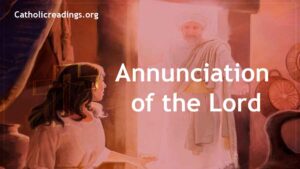The Catholic Church observes the Solemnity of the Annunciation of the Lord on March 25th every year. However, if March 25th falls on a Sunday during Lent, the celebration is moved to the following day, which is March 26th.
In years when March 25th coincides with the Holy Week, Paschal Triduum, or the Octave of Easter, the celebration is shifted to the Monday of the Second Week of Easter.
The term “annunciation” originates from the Latin word “annuntiare”, which translates to “the announcing” or “announcement”.
The occasion we commemorate is the announcement of the forthcoming birth of Jesus Christ after his conception. The biblical account of this event can be found in Luke 1:26-38.
How Did the Annunciation of the Lord Come?
Mary resided in Nazareth, a town in Galilee that is part of modern-day Israel. She was engaged to Joseph at that time.
One day, the angel Gabriel appeared to Mary and greeted her by saying “Hail” while addressing her as the “favoured one,” informing her that the Lord was with her.
This is where the opening lines of the Hail Mary prayer, “Hail Mary, full of grace, the Lord is with you,” originate from.
The Angelus Prayer is composed of this event of the Annunciation of the Lord.
Mary was startled to see the angel, but Gabriel reassured her not to be afraid. He proceeded to inform her that she was going to give birth to a son and name him Jesus.
Mary responded to the angel using these words that came to be known as Mary’s fiat. The term “fiat” is derived from Latin, which means “let it be done.” When Mary agreed to the angel’s message and said, “Behold, I am the handmaid of the Lord; let it be to me according to your word” (Luke 1:38).
This was how Mary discovered that she was going to be the mother of Jesus, and the event is referred to as the “annunciation” because Gabriel proclaimed this news to her.
Mary’s YES, and her obedience to God, undoes the disobedience of Adam and Eve that led to the “Fall.”
While Adam and Eve’s sin resulted in the closing of the gates of Paradise, Mary’s obedience led to the birth of Christ, who opened those same gates through his saving death and resurrection. Thus, Mary is often viewed as the new Eve.
It’s worth noting that this Feast Day, which commemorates the announcement of Jesus’ conception to Mary, is celebrated precisely nine months before the Solemnity of the Nativity of the Lord, which is Christmas Day, observed on December 25th.
The Annunciation is a significant event as it marks the precise moment when Jesus was conceived, and the Son of God became the son of the Virgin Mary.
This occasion has been celebrated since the 5th century AD and commemorates two essential aspects:

Firstly, it acknowledges God’s initiative to enter the human world as Jesus with the intention of saving humanity from sin and death.
Secondly, it recognizes humanity’s willingness to accept God’s action through Mary’s free decision to accept the role of being the Mother of God.
The Annunciation of the Lord was prophesied by the prophet Isaiah in Isaiah 7:14 which says, “Therefore the Lord himself will give you a sign; the young woman, pregnant and about to bear a son, shall name him Emmanuel.”
The History of March 25th
March 25th has a very rich historical background. In the olden times, it was believed that the world’s creation started on this day.
Over time, it became associated with other significant events, such as the date of the death of Jesus and also the date of the Exodus from Egypt.
At one point, March 25th was even considered to be the date of the spring equinox and marked as New Year’s Day.
In England, this day was known as “Lady’s Day,” and it remained celebrated as New Year’s Day in the country until the adoption of the Gregorian calendar in the 1750s.
Although it might seem strange to us today, we can consider how we name our months, like September (named for seven), October (named for eight), November (named for nine), and December (named for ten), counting backwards, this makes March the first month instead of the third.
During the 5th century, a feast commemorating Jesus’ conception was already being observed.
At that time, the East celebrated this feast on December 26th, while the West celebrated it on the Sunday before Christmas.
However, by the mid-6th century in the East and from the 7th century in the West, the celebration of this feast was moved to March 25th.
Related Links
Powered By SEO Experts
Follow @ReadingCatholic
